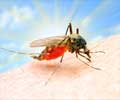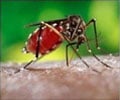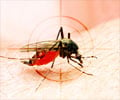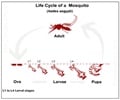Researchers at the University of Georgia have suggested that cross-immunity leads to the waxing and waning of the Dengue epidemics.
Researchers at the University of Georgia have suggested that cross-immunity created in response to infection by one serotype or viral strain protect against infection by related serotypes thus leading to the waxing and waning of the Dengue epidemics. This finding would help understand the pattern of this deadly mosquito-borne illness better.
"We found that since about the mid 1980s, there's been a sequential replacement of the dominant serotype," said lead author Helen Wearing, a post-doctoral researcher at the UGA Institute of Ecology. "So, for example, one year serotype three is 60 percent of the cases and the next year serotype two is dominant and so on. Epidemics of individual serotypes recur every eight to 10 years, but, at the same time, if you look at all the data together, you see about an average three-year cycle with some seasonal component to it."In addition to helping resolve a long-standing debate in public health, the study, published this week in the early online edition of the journal Proceedings of the National Academy of Sciences, gives researchers a framework that can be used to create models that predict dengue outbreaks in both space and time.
"It's a framework that highlights the key elements you need to take into account while developing a forecasting model," Wearing said. "Because if you were to build a forecasting model without understanding the trends in cross-immunity, you would not necessarily predict what we observe."
The researchers examined 30 years of data from the government of Thailand and from a Thai clinic that keeps what is widely regarded as the most comprehensive set of data on dengue. Southeast Asia has been a dengue hot spot since the 1950s, but the researchers note that their model applies to other regions where all four dengue strains circulate.
The researchers compared the data with results from mathematical models that explore – both independently and collectively – the role factors such as temporary cross-immunity and variation in serotype virulence play in epidemics. They found that cross-immunity alone is enough to create the patterns that are observed in nature.
The study is a major departure from other theories about what drives dengue epidemics. The conventional wisdom is that an amplification of the severity of disease caused by repeat infections with different strains, a phenomenon known as antibody-dependent enhancement, drives the boom and bust cycles of dengue epidemics.
Advertisement
"It's discussed in the scientific literature," Wearing added, "but no one ever considers it an important factor in generating the epidemiological cycles."
Advertisement
"You can't deny the empirical fact that people who get severe dengue may well have had cases before," Rohani said. "But our work suggests it's not the mechanism that's underlying the big-picture pattern that we see."
Several factors are contributing to an increase in dengue epidemics. Global warming is allowing the species primarily responsible for spreading dengue (Aedes aegypti, also known as the yellow fever mosquito) to expand its range. Population growth in developing nations is pushing more people into substandard housing in mosquito-infested areas. And the ease of travel brings the virus to areas that were previously dengue-free when a mosquito bites an infected traveler and then spreads it to others. According to the Centers for Disease Control and Prevention, Aedes aegypti and the related Aedes albopictus (the Asian tiger mosquito) have the potential to spread dengue in sporadic outbreaks in the Southern and Southeastern United States.
Rohani said the same modeling techniques he and Wearing used to study dengue can help shed light on the transmission of other multi-strain diseases such as cholera, malaria and influenza. He calls a better understanding of such diseases, "one of the most important issues in public health and epidemiology in general."
"Until now, it's been very much a single-host, single-pathogen type of framework," Rohani said. "Now with avian influenza being very much on everyone's mind, we're beginning to realize that the genetic diversity of infectious agents is really important."
Source: Eurekalert










